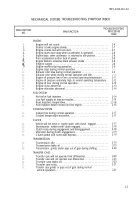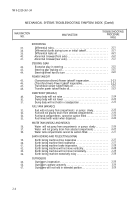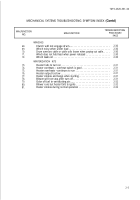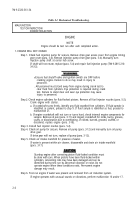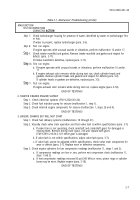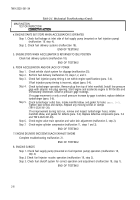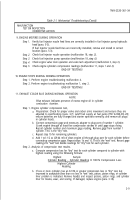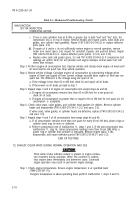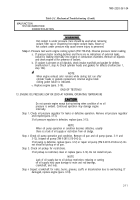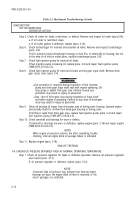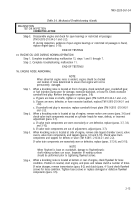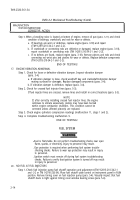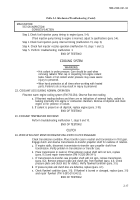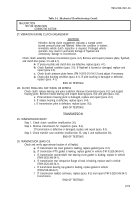TM-9-2320-361-34 - Page 28 of 764
TM9-2320-361-34
Table 2-1. Mechanical Troubleshooting (Contd).
MALFUNCTION
TEST OR INSPECTION
CORRECTIVE ACTION
Step
2.
Disassemble engine and check for spun bearings or restricted oil passages
(TM 9-2815-210-34-2-1 and -2-2).
If, during inspection, evidence of spun engine bearings or restricted oil passages is found,
replace engine (para. 3-18).
END OF TESTING!
15
ENGINE OIL LOSS DURING NORMAL OPERATION
Step 1. Complete troubleshooting malfunction 13, steps 1 and 5 through 7.
Step 2. Complete troubleshooting malfunction 11.
END OF TESTING!
16.
ENGINE NOISE ABNORMAL
Step 1.
Step
2.
Step
3.
Step
4.
NOTE
When abnormal engine noise is evident, engine should be checked
and location of noise determined to ensure that engine will not be
permanently damaged.
When a knocking noise is located at front of engine, check camshaft gear, crankshaft gear,
or fuel injection pump gear for damage, excessive backlash, or loose fit. Check excessive
camshaft end play. Remove timing gear cover (para. 3-8).
a. If gears are loose on shafts, tighten or replace gears (TM 9-2815-210-34-2-1 and -2-2).
b. If gears are worn, defective, or have excessive backlash, replace (TM 9-2815-210-34-2-1 and
-2-2).
c. If camshaft end play is excessive, replace camshaft thrust plate (TM 9-2815 -210-34-2-1
and -2-2).
When a knocking noise is located at top of engine, remove rocker arm covers (para. 3-6) and
check valve train components mounted on cylinder heads for wear, defects, or incorrect
adjustment (para. 3-7).
a. If valve train components are worn excessively or are defective, replace (paras. 3-7, 3-8,
and 3-10).
b. If valve train components are out of adjustment, adjust (para. 3-7).
When knocking noise is located at side of engine, remove side tappet chamber covers, valve
covers, valve train components, and tappets (paras. 3-9 and 3-10). Check valve train
components and tappets for defects or wear (TM 9-2815 -210-34-2-1 and -2-2).
If valve train components are excessively worn or defective, replace (paras. 3-7,3-8, and 3-10).
NOTE
When flywheel is loose on crankshaft, damage to flywheel/crank-
shaft mating surfaces can occur. Inspection of mating surfaces
should be performed prior to tightening flywheel screws.
When a knocking noise is located at bottom or rear of engine, check flywheel for loose
condition. Position in neutral, start engine, and press and release clutch a number of times.
If noise changes, remove transmission (para. 8-2) and clutch (para. 4-1) and check flywheel
screws for loose condition. Tighten loose screws or replace damaged or defective flywheel
components (para. 3-5).
2-13
Back to Top

